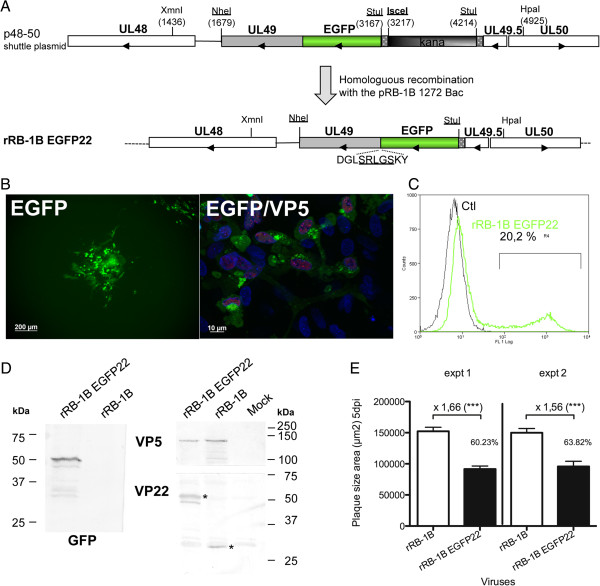Figure 1.
Construction and characterization of rRB-1B EGFP22 in cell culture. A. Schematic representation of the shuttle plasmid constructed to generate the rRB-1B EGFP22 mutant by using homologous recombination in E. coli with the pRB-1B 1272 DNA bacmid. The shuttle plasmid was derived from the p48-50 StuNhe EGFPUL49 plasmid previously described. B. Analysis of EGFP expression by fluorescence. Picture of an infection plaque visualized with EGFP fluorescence at 5 dpi (low magnification). At high magnification, infected cells were stained with an anti-VP5 capsid mouse MAb (red) and Hoechst 33342 dye, staining nuclei (blue). C. Flow cytometry analysis on CESCs infected with rRB-1B EGFP22 (green curve) or non-infected (black curve), based on EGFP fluorescence. In this experiment, about 20% of the rRB-1B EGFP22 infected cells were EGFP-positive. D. Analysis of EGFPVP22 protein expression in infected cells by immunoblot revealed with an anti-GFP or an anti-MDV VP22 antibody. The stars indicate either the EGFPVP22 or the VP22. An anti-VP5 antibody was used as a control. Mock corresponds to non-infected cells. E. Plaques size comparison. At 5 dpi, 50 plaques were stained with a cocktail of anti-MDV antibodies followed by a secondary antibody coupled to Alexafluor 594. Plaques were photographed with the cell observer system (Zeiss, Göttingen, Germany) on the red channel, and measured using the Axiovision software. The error bars represent the standard error of the mean (SEM) of the size of 50 plaques; the values on the graph indicate the plaque size ratio between rRB-1B and rRB-1B EGFP22 (***, P < 0.0001).

